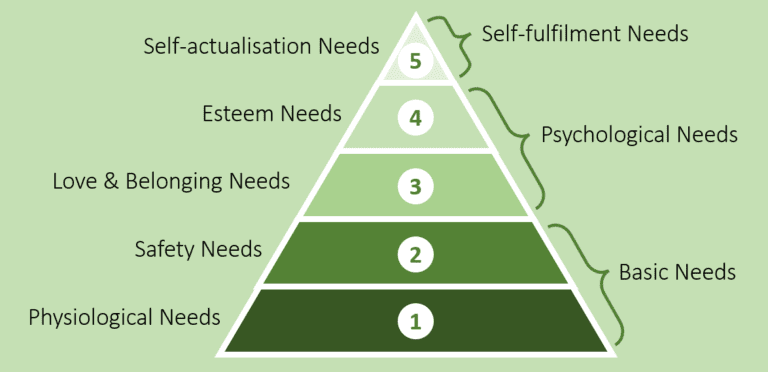Page Contents
Abraham Maslow’s Hierarchy of Needs has long been a cornerstone in understanding human motivation and behaviour. This framework, often depicted as a pyramid, suggests that individuals must satisfy lower-level needs (physiological and safety) before they can address higher-level needs (belongingness, esteem, and self-actualisation).

While this model has been influential, it may not be entirely applicable or practical in the eldercare sector, its application to eldercare presents several challenges and limitations. In this blog, we will explore the limitations of Maslow’s Hierarchy in the context of eldercare.
The complex realities of eldercare
Non-linear needs
- Maslow’s assumption
Needs must be met in a hierarchical order. - Eldercare reality
Elderly individuals often have fluctuating and overlapping needs. For instance, someone might seek companionship (belongingness) even if their health (physiological need) is compromised. The interdependency of needs in eldercare doesn’t fit neatly into a hierarchical structure.
- Maslow’s assumption
Chronic health issues
- Maslow’s assumption
Once a need is met, individuals can progress to the next level. - Eldercare reality
Many elderly individuals live with chronic conditions that continuously impact their physiological and safety needs. This ongoing struggle makes it challenging to address higher-level needs consistently.
- Maslow’s assumption
Diverse personal histories
- Maslow’s assumption
The hierarchy is a universal framework applicable to all. - Eldercare reality
Elderly residents come with diverse backgrounds and life experiences that influence their priorities and needs. Some may place higher importance on self-esteem or social connections regardless of their physical health status.
- Maslow’s assumption
Cognitive decline
- Maslow’s assumption
Cognitive abilities remain stable enough to pursue higher-level needs. - Eldercare reality
Cognitive impairments such as dementia or Alzheimer’s disease complicate the straightforward application of Maslow’s model. These conditions often necessitate a focus on safety and physiological needs, making it difficult for residents to engage in higher-level pursuits.
- Maslow’s assumption
The inverted hierarchy concept
Dennis B. Liotta, MD, MBA, proposes an alternative view where Maslow’s pyramid flips for the elderly. This perspective suggests that as people age, their priorities shift from higher-level needs such as self-actualisation and esteem back to fundamental physiological and safety needs. This shift highlights the changing nature of needs as individuals face physical decline and increased vulnerability, necessitating a focus on basic survival and security over self-fulfillment and personal growth.

Physiological and safety needs dominate
In eldercare, the emphasis often lies heavily on meeting basic physiological and safety needs. Elderly individuals frequently require assistance with activities of daily living (ADLs), specialised diets, and medications to manage chronic conditions. Ensuring safety involves creating an environment that minimises the risk of falls, injuries, and abuse, which are critical concerns for this demographic. The need for a secure and supportive environment often overshadows higher-level psychological needs, as maintaining physical health and safety becomes paramount.
Social and emotional challenges
Although social interaction and emotional support are important for the elderly, fulfilling these needs can be complex. Many elderly individuals face social isolation due to the loss of partners, friends, and decreased mobility. While Maslow’s theory emphasises the importance of love and belonging, the practical realities of eldercare often make it challenging to consistently meet these needs. Creating opportunities for meaningful social engagement and ensuring consistent emotional support require significant resources and dedicated efforts from caregivers and family members.

Re-evaluating self-esteem and self-actualisation
For many elderly individuals, traditional sources of self-esteem, such as career success and physical vitality, diminish with age. While Maslow’s hierarchy places esteem and self-actualisation at the top, elderly individuals may struggle to find new ways to achieve these needs. Opportunities for self-actualisation, such as pursuing hobbies, learning new skills, or contributing to the community, are important but can be limited by physical and cognitive decline. This reality necessitates a more nuanced approach to fostering self-esteem and personal fulfillment in the elderly, tailored to their unique abilities and circumstances.
Incorporating self-transcendence
Maslow later introduced the concept of self-transcendence, which involves focusing on goals beyond oneself, such as altruism and legacy building. This concept can be particularly relevant in eldercare, as many elderly individuals derive a sense of purpose from contributing to the well-being of others or leaving a positive legacy. Encouraging activities that promote self-transcendence, such as volunteering or sharing wisdom with younger generations, can help address higher-level psychological needs in a meaningful way.

Conclusion
While Maslow’s Hierarchy of Needs provides a valuable framework for understanding human motivation, its direct application to eldercare is limited. The evolving needs of the elderly, dominated by physiological and safety concerns, require a shift in focus from traditional hierarchical models. By acknowledging the unique challenges and priorities of elderly individuals, caregivers can better tailor their approaches to support overall well-being, incorporating elements of social interaction, emotional support, and opportunities for self-transcendence where possible.
Understanding these dynamics and adopting a flexible, responsive approach is crucial in providing effective and compassionate eldercare.
